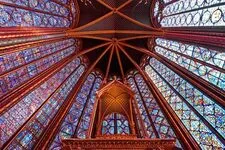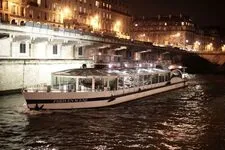Holy Chapel of Paris

Built on the Île de la Cité, the Sainte-Chapelle (also known as the Sainte-Chapelle du Palais) was specifically constructed to house the Crown of Thorns, a piece of the True Cross, and other relics of the Passion.
A monument worthy of housing the most beautiful relics
At the beginning of the 13th century, Emperor Baldwin II of Courtenay, the last emperor of Constantinople, urgently needed financial support. To be helped as quickly as possible, he put up for sale the most precious of his relics: the Crown of Thorns, that is, the crown placed on the head of Jesus Christ before his crucifixion. In the hope of finding a buyer as well as an ally to start a new crusade, he undertook a long journey through Europe in 1237 during which he met the French king Louis IX. While the latter was reluctant to embark on a new expedition, he was very interested in the Holy Crown and the relics pledged in Venice. In exchange for the sum of 135,000 livres, the Crown of Thorns was brought to France and arrived in Paris in 1239.
The next day, a grand ceremony was organized, during which the relic was placed in the Saint-Nicolas chapel of the Cité. Three years later, two new relics sold by Baldwin II joined Paris: the relic of the Passion and a part of the True Cross (the cross on which Jesus was said to have been crucified). Considered direct witnesses to the history of Jesus and his crucifixion, the three relics in the king's possession are particularly venerated by Christians. Louis IX thus decided to place these precious relics in a much more prestigious location than the small Saint-Nicolas chapel. He ordered the construction of a new chapel within the grounds of the former royal palace on the Île de la Cité, specifically intended to house the holy relics.
By the operation of the Holy Spirit…
Strangely, the name of the architect behind the Sainte-Chapelle remains uncertain to this day. The name Pierre de Montreuil has been mentioned in some writings, but no text truly confirms this hypothesis. In 1240, this architect, whose life is poorly documented and whose works are disputed, was already a man of a certain age who enjoyed the king's favor. While some texts suggest his name, none certify that he is indeed the author of the project. The name of the architect of the Sainte-Chapelle thus remains uncertain.
Nevertheless, in 1242, construction began and was completed in 1248; an achievement considering the magnificent architectural outcome that the chapel represents. No technical or stylistic errors were made. The chapel is simply a true example of precision and architectural finesse.
Lower chapel and upper chapel
Entirely dedicated to the Virgin, the lower chapel of the Sainte-Chapelle was once reserved for the palace regulars. It captivates with the dimness that reigns there. This almost mystical lighting is due to the small size of the windows that adorn this room, whose ceiling, situated quite low, is the floor of the upper chapel.
Dedicated to the relics of the Crucifixion and located above the lower chapel, the upper chapel is directly connected to the first floor of the Palais Royal by a small door. Access to the upper chapel was thus entirely reserved for the royal family at the time. The atmosphere, the airy architectural style, the vast stained glass windows, and the warmly colored light present in this room contrast remarkably with the dimness of the lower chapel. At the back of the room, a massive rose window dominates the entrance and floods the floor, walls, and sculptures of the chapel with light.
A symbol of beleaguered royalty
A true emblem of royalty, the Sainte-Chapelle was one of the first targets of the revolutionaries of 1789. While two-thirds of its stained glass windows are from the period, the various restorations the building has undergone have removed some of its panels. Similarly, among the twelve statues of the apostles located at the base of the pillars of the ribbed vaults, only those adorning the platform in front of the apse are authentic. The other statues are replicas, the originals of which, damaged during the French Revolution, have been stored in the Cluny Museum.
The furniture, as well as the stalls, the jubé, and all royal insignia were also destroyed during this period. The reliquaries and boxes were transferred to the Hôtel de la Monnaie to be melted down. Ultimately, only the Crown of Thorns was saved from this carnage. To make room for the shelving, two meters of stained glass were removed from the upper chapel, which was temporarily converted into an archive depot. Most of the stained glass thus removed was sold to England.
From 1840 to 1868, work was finally undertaken to restore the entire building to its original appearance and heritage value.
Avoid the queues by purchasing your tickets for the Sainte-Chapelle in advance.
Activities in the Surroundings

Sainte-Chapelle in Paris

Centre Pompidou - Beaubourg

